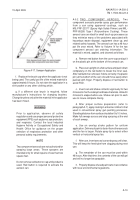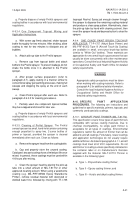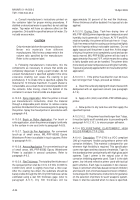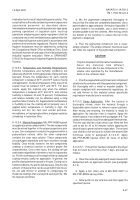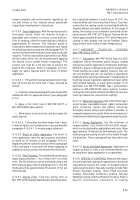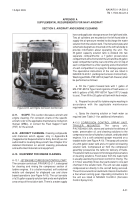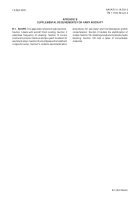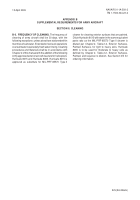TM-1-1500-344-23-2 - Page 199 of 240
A-29
NAVAIR 01-1A-509-2
TM 1-1500-344-23-2
15 April 2009
remain compliant with environmental regulations, do
not add thinner to this material unless specifically
required per manufacturer’s instructions.
A-10.6.4. Spray Application. After the epoxy topcoat is
thoroughly stirred, strain the material through a
disposable paint strainer to remove coarse particles.
Prior to spraying, allow the mixed topcoat to stand for
approximately 30 minutes. This induction period is
necessary to allow components to partially react. Spray
the mixed topcoat in accordance with paragraph A-8. To
achieve the desired film thickness, two coats are usually
required. The first coat shall be a light (mist) coat. Allow
the first coat to set for 30 to 60 minutes before applying
the second coat to permit solvent evaporation. The
second coat shall be a full wet coat to achieve the
desired film thickness. Refer to paragraph A-10.6.6.
Apply the epoxy topcoat within 24 hours of primer
application.
A-10.6.4.1. If the primer has been allowed to dry longer
than 24 hours but not more than 7 days, proceed as
follows:
a. Clean the surface by wiping with clean cheesecloth
dampened with an approved solvent (see paragraph
A-7.4).
b. Apply a thin (mist) coat of MIL-PRF-23377 or
MIL-PRF-85582 epoxy primer.
c. Allow primer to dry tack-free and then apply the
epoxy topcoat.
A-10.6.4.2. If the primer has dried longer than 7 days,
it must be lightly scuff sanded prior to proceeding with
paragraph A-10.6.4.1, to ensure proper adhesion.
A-10.6.5. Brush or Roller Application. For brush or
roller application, strain the epoxy topcoat and allow it
to stand for 30 minutes as per paragraph A-10.6.4.
Apply one uniform coat to the surface (refer to paragraph
A-8.5) and allow it to dry tack-free before applying an
additional coat to achieve the desired film thickness.
A-10.6.6. Film Thickness. The total dry film thickness of
epoxy topcoat shall be 1.7 to 2.3 mils (0.0017 to 0.0023
inch). Dry film thickness can be estimated using a wet
film thickness gage (refer to paragraph A-5.7). Dry film
thickness will be approximately 50 percent of the wet
film thickness.
A-10.6.7. Drying Time. Tack-free drying time of
MIL-PRF-22750 topcoat depends upon the temperature,
but is generally between 2 and 6 hours. At 70
°
F, the
material will be tack-free in less than 5 hours. Tack-free
means that the coating can be touched lightly with the
fingertip without noticeable tackiness. At this stage of
drying, the coating is not completely cured and can be
easily marred. MIL-PRF-22750 Epoxy Topcoat will dry
hard in approximately 8 hours at 70
°
F, which means the
coating is fairly durable and can be handled. Epoxy
topcoat dries more slowly at lower temperatures.
A-10.7. AIRCRAFT
TOUCH-UP
COATING
(MIL-PRF-81352 TYPE I).
A-10.7.1. Description. MIL-PRF-81352 Type I is a VOC
compliant (340 g/l maximum) acrylic lacquer coating
that can be used for application of temporary markings/
MODEX. Lacquer coatings dry by solvent evaporation.
These coatings are easily applied; however, they are
not very durable and are not resistant to operational
fluids and some cleaning compounds. For application of
markings, lacquer is generally applied over clean, lightly
scuff sanded topcoats. In areas where lacquer is not
permitted, use MIL-PRF-85285 Type I polyurethane
topcoat or MIL-PRF-22750 epoxy topcoat. Lacquer
coatings do not provide sufficient durability for use as a
touch-up material for conventional coatings.
A-10.7.2. Material Preparation. MIL-PRF-81352 Type I
acrylic lacquer is available in quart, gallon, and aerosol
(pint) containers. Quarts and gallons should be
thoroughly mixed, using a paint shaker if possible, to
completely disperse the solids. Refer to manufacturer’s
instructions for obtaining the appropriate spray viscosity.
A-10.7.3. Spray Application. Dry film thickness of
lacquer shall be 1.5 to 2.0 mils (0.0015 to 0.0020 inches),
which can be obtained by applying two wet coats. Allow
approximately 15 minutes dry time between coats. The
underlying paint coating should not be visible through
the dried film. These coatings will dry hard within two
hours.
A-10.7.4. Brush and Roller Application. Application of
lacquer by brush or roller is not recommended but can
be used when spray application is not permitted.
A-10.8. SPECIALTY COATINGS. Many aircraft require
the use of specialty coatings for operational or functional
requirements beyond the scope of standard primer/
topcoat paint systems. Specialty coatings include Rain
Erosion Resistant Coating, Teflon Filled Anti-chafe
Coating, Electrically Conductive Coating, Non-slip
Walkway Coating, and Heat Resistant Coating. Refer to
specific maintenance instructions for coating
Back to Top

